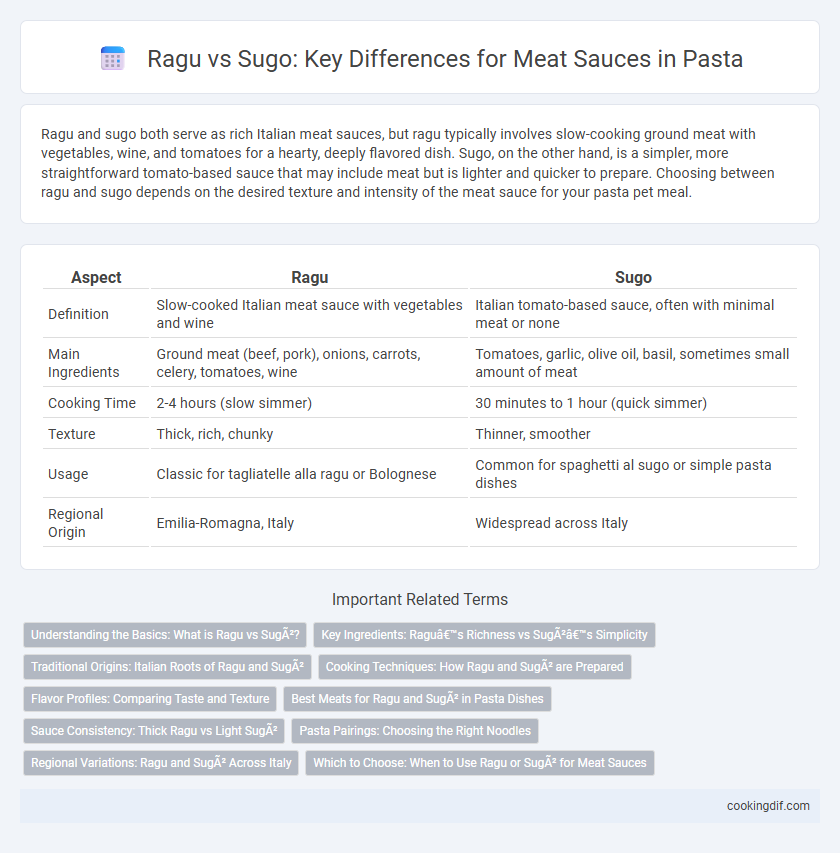Ragu and sugo both serve as rich Italian meat sauces, but ragu typically involves slow-cooking ground meat with vegetables, wine, and tomatoes for a hearty, deeply flavored dish. Sugo, on the other hand, is a simpler, more straightforward tomato-based sauce that may include meat but is lighter and quicker to prepare. Choosing between ragu and sugo depends on the desired texture and intensity of the meat sauce for your pasta pet meal.
Table of Comparison
| Aspect | Ragu | Sugo |
|---|---|---|
| Definition | Slow-cooked Italian meat sauce with vegetables and wine | Italian tomato-based sauce, often with minimal meat or none |
| Main Ingredients | Ground meat (beef, pork), onions, carrots, celery, tomatoes, wine | Tomatoes, garlic, olive oil, basil, sometimes small amount of meat |
| Cooking Time | 2-4 hours (slow simmer) | 30 minutes to 1 hour (quick simmer) |
| Texture | Thick, rich, chunky | Thinner, smoother |
| Usage | Classic for tagliatelle alla ragu or Bolognese | Common for spaghetti al sugo or simple pasta dishes |
| Regional Origin | Emilia-Romagna, Italy | Widespread across Italy |
Understanding the Basics: What is Ragu vs Sugò?
Ragu is a slow-cooked Italian meat sauce traditionally made with ground or finely chopped meats, simmered with tomatoes, wine, and aromatic vegetables to develop a rich, hearty flavor and thick texture. Sugo, on the other hand, refers broadly to any tomato-based sauce and can be either meat-based or vegetarian, typically lighter and simpler in preparation compared to ragu. Understanding these distinctions helps in selecting the right sauce for dishes like pasta, where ragu delivers depth and sugo offers a fresh, vibrant complement.
Key Ingredients: Ragu’s Richness vs Sugò’s Simplicity
Ragu features a complex blend of ground meat, soffritto (onion, carrot, celery), tomatoes, wine, and long-simmered broth, creating a rich and hearty sauce. Sugo emphasizes simplicity with fewer ingredients, often just tomatoes, garlic, olive oil, and occasionally meat, focusing on bright and fresh flavors. This distinction highlights ragu's depth versus sugo's straightforwardness in traditional Italian meat sauces.
Traditional Origins: Italian Roots of Ragu and Sugò
Ragu originates from Northern Italy, especially Emilia-Romagna, where it traditionally includes a slow-cooked mixture of finely chopped or ground meat, soffritto, tomatoes, and wine, creating a rich, hearty sauce. Sugo, common in Southern Italy, often features whole or larger pieces of meat simmered in a more pronounced tomato base with herbs, reflecting the lighter, tomato-forward flavors of the region. Both sauces showcase distinct regional Italian culinary techniques and ingredients, underscoring the cultural diversity within Italy's meat sauce traditions.
Cooking Techniques: How Ragu and Sugò are Prepared
Ragu is typically slow-cooked for several hours, allowing the meat, vegetables, and tomatoes to meld into a rich, thick sauce through a process of simmering and reduction. Sugo, on the other hand, is often made with fewer ingredients and cooked for a shorter time, resulting in a lighter, more tomato-forward sauce that can include sauteed meat or vegetables but lacks the prolonged cooking that develops ragu's depth. The difference in cooking techniques highlights ragu's complexity and sugo's simplicity, influencing texture, flavor intensity, and sauce consistency.
Flavor Profiles: Comparing Taste and Texture
Ragu offers a rich, slow-cooked flavor with tender, minced meat that creates a hearty texture, blending deeply infused tomato and wine notes. Sugo, by contrast, features a lighter, fresher tomato base with larger meat chunks or whole pieces, resulting in a more distinct and vibrant taste. The difference in cooking time and meat preparation fundamentally shapes ragu's intensity versus sugo's bright, straightforward flavor profile.
Best Meats for Ragu and Sugò in Pasta Dishes
Ragu traditionally uses tougher, fattier cuts like beef chuck, pork shoulder, or veal shanks that break down slowly, creating a rich, hearty sauce ideal for slow cooking. Sugo typically features leaner meats such as ground beef, sausage, or chicken, resulting in a lighter, quicker-cooking sauce. Both sauces benefit from high-quality meat that enhances depth of flavor and complements the pasta, with ragu suited for robust, slow-simmered dishes and sugo suited for simpler, everyday meals.
Sauce Consistency: Thick Ragu vs Light Sugò
Ragu features a thick, hearty consistency achieved by slow-cooking tomatoes with finely chopped meat, allowing the sauce to reduce and intensify in flavor. Sugo, in contrast, offers a lighter texture with a more fluid base, often combining whole or crushed tomatoes with minimal meat or none at all. This distinction in sauce consistency affects how each pairs with different pasta shapes, with ragu better suited for robust noodles and sugo complementing delicate strands.
Pasta Pairings: Choosing the Right Noodles
Ragu, a slow-cooked meat sauce with rich, chunky texture, pairs best with wide noodles like pappardelle or tagliatelle that can hold the hearty sauce. Sugo, a lighter tomato-based sauce often with finely ground meat, complements thinner pasta such as spaghetti or linguine, allowing the delicate flavors to shine. Selecting the right noodle enhances the balance between sauce consistency and pasta shape, creating an optimal taste experience.
Regional Variations: Ragu and Sugò Across Italy
Ragu and sugo exhibit distinct regional variations across Italy, with ragu traditionally associated with Northern regions like Emilia-Romagna, especially Bologna, featuring slow-cooked minced meat and rich tomato bases. Sugo is more common in Southern Italy, particularly Campania and Sicily, where it is typically a lighter, quicker-cooking tomato sauce often paired with whole meat cuts or seafood. These regional preferences reflect local ingredients and culinary traditions, influencing texture, cooking time, and flavor profiles in Italian meat sauces.
Which to Choose: When to Use Ragu or Sugò for Meat Sauces
Ragu is a hearty Italian meat sauce slow-cooked with tomatoes, vegetables, and wine, ideal for richer pasta dishes like pappardelle or tagliatelle. Sugo, a simpler tomato-based sauce, works best for lighter dishes or quick meals where a delicate meat flavor is preferred. Choosing ragu or sugo depends on the desired intensity and cooking time, with ragu offering depth and complexity, while sugo provides freshness and simplicity.
ragu vs sugo for meat sauces Infographic

 cookingdif.com
cookingdif.com